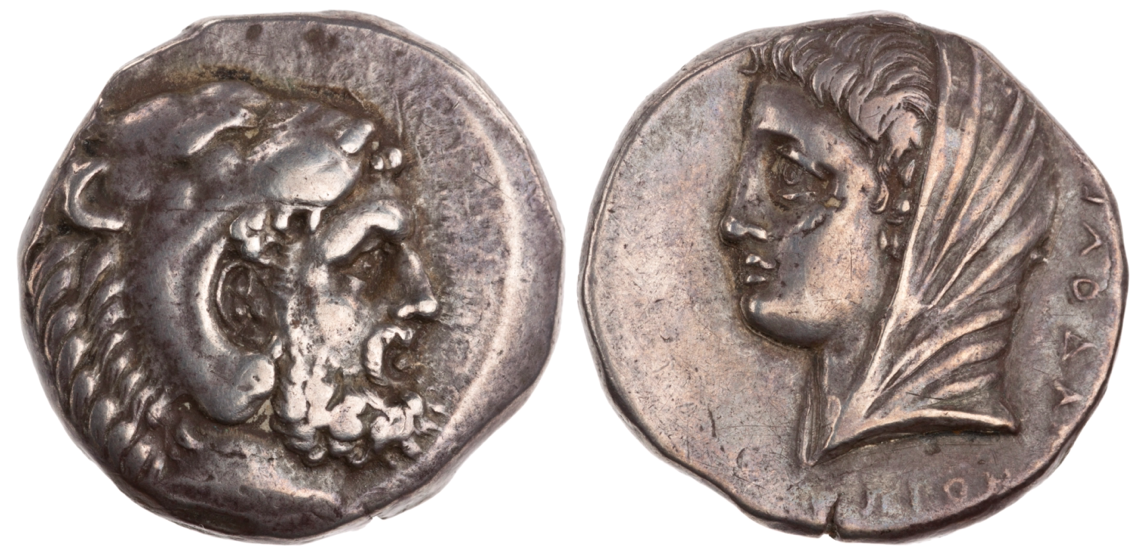Cos, silver, tetradrachms (Heracles/veiled female head) (365-55 BCE) Ingvaldsen
From SILVER
365 BCE - 355 BCE Silver 2,499 kg
Description
| ObverseInscription or printing placed on the obverse.: | Head of Heracles right, bearded, wearing Nemean lion skin headdress. |
| ReverseInscription or printing placed on the reverse.: | Female head left, wearing veil. |
Mint and issuing power
| MintIdentifies the place of manufacture or issue of a numismatic object.: | Cos | Ancient regionAncient region.: | Caria (islands) | Modern countryModern country: Greece | AuthorityIdentifies the issuing power. The authority can be "pretended" when the name or the portrait of X is on the coin but he/she was not the issuing power. It can also be "uncertain" when there is no mention of X on the coin but he/she was the issuing power according to the historical sources: |
Chronology
| FromIdentifies the initial date in a range assigned in a numismatic context. | 365 BCE | toIdentifies the final date in a range assigned in a numismatic context.. | 355 BCE | PeriodTime period of the numismatic object.: Classical 480-323 BC |
Physical description
| MetalThe physical material (usually metal) from which an object is made.: | Silver |
Median weightMedian of the weights of numismatic objects (in grams). in grams | 15.20 | DenominationTerm indicating the value of a numismatic object. Examples: tetradrachm, chalkous, denarius.: | tetradrachm |
StandardStandard.: |
Image

RQEM_ad_285.png "New York, 1968.184.3 (http" has not been listed as valid URI scheme.[New York, 1968.184.3 (http://numismatics.org/collection/1968.184.3)]
References
| Die study referencePublication of the study: | Ingvaldsen 20021Ingvaldsen 2002, p. 219-222 (series III) | ||
| Coin series referenceReference to coin series study: | Sear II2Sear II, n° 4988, HGC 63HGC 6, n° 1303-1304, Stefanaki 20124Stefanaki 2012, p. 205-209, n° 460-536 (6.12) | ||
| Coin series web referenceCoin series web references: | |||
Obverse dies distribution
| FrequencyFrequency of specimen in distribution. ᵖ | Number of obversesNumber of obverse dies. ᵖ (o) | % (o) | Number of coinsNumber of coins. (n) | % (n) | Die nameName(s) of the die(s). |
| 1 | 4 | 50 | 4 | 5.71 | 1, 3, 4, 8 |
| 3 | 1 | 12.5 | 3 | 4.29 | 5 |
| 7 | 1 | 12.5 | 7 | 10 | 2 |
| 24 | 1 | 12.5 | 24 | 34.29 | 6 |
| 32 | 1 | 12.5 | 32 | 45.71 | 7 |
| Total | 8 of 8 | 100 | 70 of 70 | 100 |
Reverse dies distribution
no distribution is available
Quantification
| Number of obversesNumber of obverse dies. ᵖ (o) | 8 | Number of singletons (o1)The number of singleton coins. ᵖ | 4 |
| Number of reverse diesNumber of reverse dies. (r) | 15 | Number of coinsNumber of coins. (n) | 70 |
| Coins per obverse dieNumber of coins per obverse die. (n/o) | 8.75 | Coins per reverse dieNumber of coins per reverse die. (n/r) | 4.67 |
| Reverse per obverse ratioRatio of obverse dies divided by reverse dies. (r/o) | 1.88 | Percentage of singletons (o1)number of coins (n) divided by the number of singletons (o1) ᵖ | 50 % |
| Original number of dies (O) (Carter 1983 formula)The estimation of the number of coins according to Carter 1983 ᵖ | 8.22 | Coins struck if 20,000 as average productivity per dieCoins made if the average productivity for obverses (according to Carter) is 20,000. ᵖ | 164,400 |
| Original number of dies (O) (Esty 2011 formula)The estimation of the number of coins according to the singleton formula in Esty 2011 ᵖ (O) | 9.03 | Survival rate if 20,000 as average productivity per dieSurvival rate if average productivity is 20,000. ᵖ | 0.00043 |
| Coverage (o = % of O) (Esty 1984 formula)Esty 1984 - coverage (% of O) ᵖ (o = % of O) | 94.29% | Die productivity if survival rate 1/2,000Average productivity if survival rate is 1/2,000. ᵖ | 17,031.63 |
| Weight of silver (in kg) if 20,000 coins per die (O = Carter formula)Carter 1983 * Median weight * 20000 (*10 if gold or electrum) ᵖ | 2,499 kg <br /> 2,499 kg | Die productivity if survival rate 1/5,000Average productivity if survival rate is 1/5,000. ᵖ | 42,579.08 |
Remarks
Most likely two workstations
References
- ^ Ingvaldsen, Håkon (2002), Cos. Coinage and Society. The chronology and function of a city-state coinage in the Classical and Hellenistic period, c. 390 - c. 170 BC, unpublished doctoral dissertation, Oslo University.
- ^ Sear, David R. (1979), Greek coins and their values. Vol. II, Asia and North Africa, London, xlviii, p. 317-762
- ^ Hoover, Oliver D. (2010), The Handbook of Greek Coinage Series, volume 6 : handbook of coins of the islands: Adriatic, Iionian, Thracian, Aegean, and Carpathian seas (excluding Crete and Cyprus), sixth to first centuries BC, Lancaster, 358 p.
- ^ Stefanaki, Vassiliki E. (2012), Nomismata. Nomismatike Aigaiou : Kos I, Athens, 531 p.